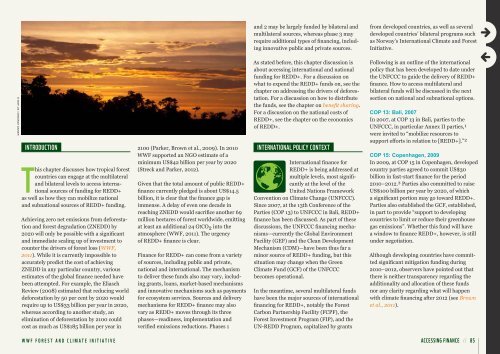WWF Guide to Building REDD+ Strategies
WWF Guide to Building REDD+ Strategies
WWF Guide to Building REDD+ Strategies
You also want an ePaper? Increase the reach of your titles
YUMPU automatically turns print PDFs into web optimized ePapers that Google loves.
© <strong>WWF</strong>-US / DEBORAH GAINER<br />
intRoduCtion<br />
this chapter discusses how tropical forest<br />
countries can engage at the multilateral<br />
and bilateral levels <strong>to</strong> access international<br />
sources of funding for <strong>REDD+</strong><br />
as well as how they can mobilize national<br />
and subnational sources of <strong>REDD+</strong> funding.<br />
Achieving zero net emissions from deforestation<br />
and forest degradation (ZNEDD) by<br />
2020 will only be possible with a significant<br />
and immediate scaling up of investment <strong>to</strong><br />
counter the drivers of forest loss (<strong>WWF</strong>,<br />
2011). While it is currently impossible <strong>to</strong><br />
accurately predict the cost of achieving<br />
ZNEDD in any particular country, various<br />
estimates of the global finance needed have<br />
been attempted. For example, the Eliasch<br />
Review (2008) estimated that reducing world<br />
deforestation by 50 per cent by 2020 would<br />
require up <strong>to</strong> US$33 billion per year in 2020,<br />
whereas according <strong>to</strong> another study, an<br />
elimination of deforestation by 2100 could<br />
cost as much as US$185 billion per year in<br />
<strong>WWF</strong> FOREST AND CLIMATE INITIATIVE<br />
2100 (Parker, Brown et al., 2009). In 2010<br />
<strong>WWF</strong> supported an NGO estimate of a<br />
minimum US$42 billion per year by 2020<br />
(Streck and Parker, 2012).<br />
Given that the <strong>to</strong>tal amount of public <strong>REDD+</strong><br />
finance currently pledged is about US$14.5<br />
billion, it is clear that the finance gap is<br />
immense. A delay of even one decade in<br />
reaching ZNEDD would sacrifice another 69<br />
million hectares of forest worldwide, emitting<br />
at least an additional 24 GtCO2 in<strong>to</strong> the<br />
atmosphere (<strong>WWF</strong>, 2011). The urgency<br />
of <strong>REDD+</strong> finance is clear.<br />
Finance for <strong>REDD+</strong> can come from a variety<br />
of sources, including public and private,<br />
national and international. The mechanism<br />
<strong>to</strong> deliver these funds also may vary, including<br />
grants, loans, market-based mechanisms<br />
and innovative mechanisms such as payments<br />
for ecosystem services. Sources and delivery<br />
mechanisms for <strong>REDD+</strong> finance may also<br />
vary as <strong>REDD+</strong> moves through its three<br />
phases—readiness, implementation and<br />
verified emissions reductions. Phases 1<br />
and 2 may be largely funded by bilateral and<br />
multilateral sources, whereas phase 3 may<br />
require additional types of financing, including<br />
innovative public and private sources.<br />
As stated before, this chapter discussion is<br />
about accessing international and national<br />
funding for <strong>REDD+</strong>. For a discussion on<br />
what <strong>to</strong> expend the <strong>REDD+</strong> funds on, see the<br />
chapter on addressing the drivers of deforestation.<br />
For a discussion on how <strong>to</strong> distribute<br />
the funds, see the chapter on benefit sharing.<br />
For a discussion on the national costs of<br />
<strong>REDD+</strong>, see the chapter on the economics<br />
of <strong>REDD+</strong>.<br />
inteRnational PoliCy Context<br />
International finance for<br />
<strong>REDD+</strong> is being addressed at<br />
multiple levels, most significantly<br />
at the level of the<br />
United Nations Framework<br />
Convention on Climate Change (UNFCCC).<br />
Since 2007, at the 13th Conference of the<br />
Parties (COP 13) <strong>to</strong> UNFCCC in Bali, <strong>REDD+</strong><br />
finance has been discussed. As part of these<br />
discussions, the UNFCCC financing mechanisms—currently<br />
the Global Environment<br />
Facility (GEF) and the Clean Development<br />
Mechanism (CDM)—have been thus far a<br />
minor source of <strong>REDD+</strong> funding, but this<br />
situation may change when the Green<br />
Climate Fund (GCF) of the UNFCCC<br />
becomes operational.<br />
In the meantime, several multilateral funds<br />
have been the major sources of international<br />
financing for <strong>REDD+</strong>, notably the Forest<br />
Carbon Partnership Facility (FCPF), the<br />
Forest Investment Program (FIP), and the<br />
UN-REDD Program, capitalized by grants<br />
from developed countries, as well as several<br />
developed countries’ bilateral programs such<br />
as Norway’s International Climate and Forest<br />
Initiative.<br />
Following is an outline of the international<br />
policy that has been developed <strong>to</strong> date under<br />
the UNFCCC <strong>to</strong> guide the delivery of <strong>REDD+</strong><br />
finance. How <strong>to</strong> access multilateral and<br />
bilateral funds will be discussed in the next<br />
section on national and subnational options.<br />
COP 13: Bali, 2007<br />
In 2007, at COP 13 in Bali, parties <strong>to</strong> the<br />
UNFCCC, in particular Annex II parties,¹<br />
were invited <strong>to</strong> “mobilize resources <strong>to</strong><br />
support efforts in relation <strong>to</strong> [<strong>REDD+</strong>].”²<br />
COP 15: Copenhagen, 2009<br />
In 2009, at COP 15 in Copenhagen, developed<br />
country parties agreed <strong>to</strong> commit US$30<br />
billion in fast-start finance for the period<br />
2010–2012.³ Parties also committed <strong>to</strong> raise<br />
US$100 billion per year by 2020, of which<br />
a significant portion may go <strong>to</strong>ward <strong>REDD+</strong>.<br />
Parties also established the GCF, established,<br />
in part <strong>to</strong> provide “support <strong>to</strong> developing<br />
countries <strong>to</strong> limit or reduce their greenhouse<br />
gas emissions”. Whether this fund will have<br />
a window <strong>to</strong> finance <strong>REDD+</strong>, however, is still<br />
under negotiation.<br />
Although developing countries have committed<br />
significant mitigation funding during<br />
2010–2012, observers have pointed out that<br />
there is neither transparency regarding the<br />
additionality and allocation of these funds<br />
nor any clarity regarding what will happen<br />
with climate financing after 2012 (see Brown<br />
et al., 2011).<br />
aCCeSSinG FinanCe // 85

















